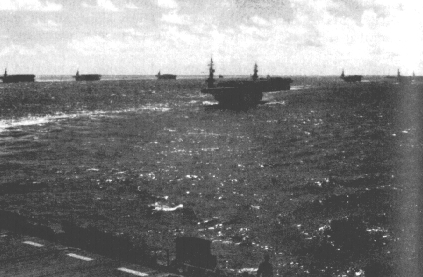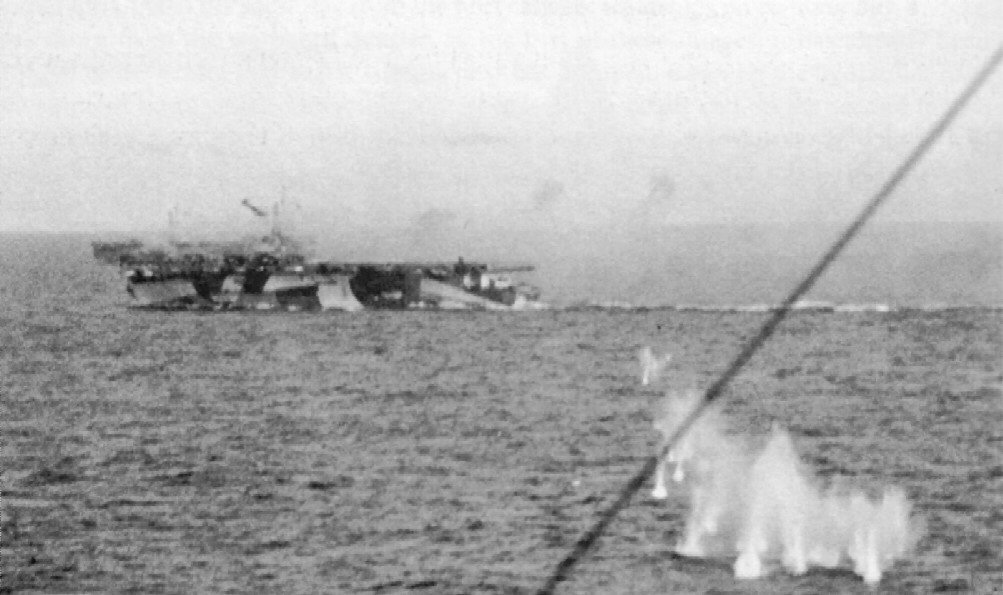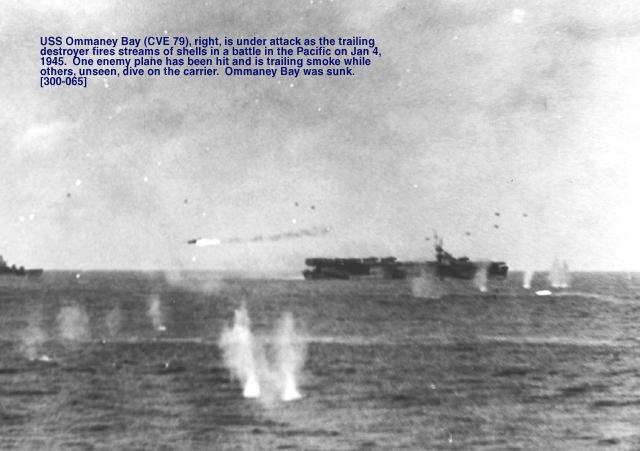
 Escort carriers (including U.S.S. Savo Island to the left) enroute to Lingayen Gulf on 1/1/1945.
Escort carriers (including U.S.S. Savo Island to the left) enroute to Lingayen Gulf on 1/1/1945.
The invasion of Lingayen Gulf was part of the campaign to recapture the Philippines. On Jan 9, the Allies landed a massive for of over 200,000 men over a 20 mile beachhead, overwhelming the opposition. The worst part of the invasion was the kamikaze attacks. From Jan 4-12, a total of 24 ships were sunk and 67 damaged by Kamikaze planes.
The U.S.S. Savo Island was part of the invasion fleet and was assigned to the San Fabian Carrier Group (TU-77.4.2) under Rear Admiral Felix B. Stump. On Jan 5, the U.S.S. Savo Island received minor damage caused by a near-miss kamikaze which the ship blinded by shining her searchlight into the pilot's face. The plane's wingtip clipped a radar antenna.
 Picture of U.S.S. Savo Island taken just as plane makes near miss.
Picture of U.S.S. Savo Island taken just as plane makes near miss.
VC-27 joined the action with 24 Wildcats and 9 Avengers. VC-27 provided support to both the ground troops and the fleet. In supporting this invasion, VC-27:
- Flew a record 759 sorties and 2,638 hours.
- Destroyed 25 aircraft, 3 ships and a submarine.
- Damaged 1 aircraft and 6 ships and scored 2 hits on Japanese Men O' War.
- Damaged or destroyed 65 ground targets.
 During this action, another escort carrier, the U.S.S. Ommaney Bay (CVE 79) was sunk by kamikaze attacks.
During this action, another escort carrier, the U.S.S. Ommaney Bay (CVE 79) was sunk by kamikaze attacks.
|
It was during this action on the 12th that the "skipper" had a bizarre happening. He was flying a routine bombing patrol looking for targets when he saw what appeared to be a Japanese hospital with a large red cross painted on its roof northeast of Pozorrubic. But he thought it strange that there seemed to be no activity around the building and large tire tracks from heavy trucks in the surrounding mud indicated something was amiss. Since he had been forewarned that the Japs were noted for storing weapons in hospitals to conceal them, in violation of the Geneva Convention, he decided to take a chance; he'd be a hero or a scapegoat! As he was making his bombing run, it occurred to him that if there was ammunition stored there he'd be blown out of the sky in the ensuing explosion, so he went around again making his approach from a higher altitude. Good decision - it was an ammunition dump and he said it was the biggest explosion he had ever seen! Ens. Frederick (Fritz) T. Vocke - Fighter Pilot now of Hagerstown, Maryland - related the following: "... The 'skipper' was flying his TBM as forward air observer and coordinator during one of our air strikes. As was his custom he flew low altitudes and selected targets of opportunity, for those of us circling to attack those targets, that he would mark with a stream of tracers. Somewhere that day he picked up some small arms fire that disabled his [tail] hook mechanism ... " Without his arresting tailhook he was not able to land aboard his carrier because they had run out of barrier wires. He ditched in the ocean and he and his crew were fortunate enough to be picked up by the destroyer USS Hall (DD-583). The chief hangar deck mechanic, Aviation Machinist's Mate 1st Class Carl L. Hawk, now of Albuquerque, New Mexico relates: "I remember everything about it because I had serviced the tail hook the night before during a routine maintenance check. The day of the water landing they announced over the ship's PA system that Commander Jackson could not get the tail hook down and he would be making a water landing along the starboard side of the ship. They also announced that if your duty permitted, you could watch the water landing. My first reaction was, 'I worked on the tail hook on Commander Jackson's plane - what will happen to me?' In my mind I went over the whole procedure and couldn't think of anything I had done wrong, but still??? I went up to the flight deck with hundreds of others to watch. [The "Skipper" was] coming in low, with flaps down, and skimming the water a short distance from our vantage point. The TBM touched the water and came to a stop. [The pilot] and two crewmen climbed out on the wing, barely getting their shoes wet. A TBM will float nicely with the top of the wing above water if the sea is calm. A destroyer immediately had a whaleboat in the water and [they] got into the whaleboat and were taken to the destroyer. All three came back aboard our carrier by breeches buoy. As soon as the first aircrewman touched the deck, I grabbed him and asked: 'Why wouldn't the tail hook come down?' His answer: 'It was shot up.' I let out a sigh of relief knowing that it was not my fault. When [the "Skipper"] realized that he couldn't get the hook down, he asked the crewman to hack through the bulkhead to see if they might be able to push the hook down. When they made a hole using an emergency ax and looked in, they saw that there was no hope of pushing the hook down ... This track and hook were all damaged either by flack or a direct hit." AOM 1st Le Blanc, the "Skippers" ball-turret gunner, confirmed that they hardly got their shoes wet but complained: "Radioman Snider and I had spent the previous night Simonizing the plane in the hopes of getting a few more knots of airspeed, but here we were in the water knowing that we were going to lose the plane on which we had worked so hard!" Ens. Vocke continues: "... I remember the self-conscious smile [the "Skipper"] had coming back aboard and how glad we all were to have him back safely (he felt the same way, I'm sure) ... " He and his aircrewmen were immediately installed in the "Goldfish Club" (members of aircraft crews forced down and fished out of the sea). During this campaign the squadron suffered no loss from combat but tragedy struck when a TBM crashed into the sea while preparing for a carrier landing; the pilot, Lt. Maurice A. Coleman of Salsbury, North Carolina, and two aircrewmen, AMM 21c Joseph Prusacowski of Perth Amboy, New jersey and ARM 2/c Anthony T. Servalli of Philadelphia, Pennsylvania, were killed. Strong gusty winds and heavy swells, however, caused hazardous operating conditions resulting in the loss of five FM-2's and another TBM when a TBM pilot, during the pitching and yawing of the decks, overshot the barrier and landed in the middle of a large group of planes parked on the flight deck. Vocke observed as he was waiting to land his FM-2: " ... I saw debris fly through the air; two FM-2's go splashing into the sea off both the port and starboard corners of the flight deck and one nose up on the prow where it stayed ... there were no casualties in the crew of the TBM or deck handlers, fortunately ... " There were, however, no VC-27 personnel lost to enemy action during this campaign. Ensign Robert H. Cockle, (replacement fighter pilot who joined the squadron in November 1944 after the Battle of Leyte Gulf) now of Sun City West, Arizona related how bad things could get " ... [Flying CAP] most of these totally boring flights [seemed to be] left up to those of us who were new to the squadron. Some 4 hours was needed so it was a boring time. No bathroom, hotter the H%^&^* with the sun pouring down on you, and trying to save gas to get back to the carrier ... and there was always the possibility that the carrier had to go into action and MIGHT NOT be where it was supposed to ... [after a CAP where we supported Army Air Corps B-24's bombing Corregidor Island], we headed back to the carrier ... we saw that there were tremendous swells on the sea, and that the carrier would plunge into the swells taking green water over the flight deck then point its bow upward with the stern dropping down. First time I had seen the deck like that. The TBM made the first landing pass, and was waved off as the ship dived into a swell. I made the second approach and thought I was to get a wave off. Instead it was a CUT, so I chopped the throttle- The nose of the ship was going down, and I did not catch any of the landing wires with my tailhook All I remember was a sudden stop, and all of a sudden I was upside down on the deck I had flown into the one-inch steel cable landing net that sewed as a barrier for the planes parked up forward. I immediately released my 4-point safety shoulder and seat belt as I was afraid the plane would catch fire (We sat on top of the gas tank). As I released I fell out of the plane and hit the deck with the top of my head ... I had just gotten away from the plane when the deck crew came and pushed the wreckage of the plane overboard. The TBM had not landed and the deck had to be cleared for him ... A normal day in VC-27!! Seeing Corregidor, with the Japs still on it, watching the Army Air Corps bombing the island, coming back to the ship and wrecking a Navy airplane!!!! ... As a follow up to my crash landing: Nobody ever said a word to me!!! Whether right or wrong I cost the Navy probably $1 00,000 worth of airplane. " Never-the-less, VC-27's performance continued to be outstanding with a total of 25 Jap planes destroyed (11 "Zekes", 7 Kawasaki Ki-61 "Hien" fighters (code named "Tony"), 3 "Vals"', 2 Mitsubishi Ki-2 1 twin-engined, five-seat heavy bombers (codenamed "Sally"), 1 'Yak" and 1 Nakajimi B6N "Tenzan" (i.e.: heavenly cloud) torpedo bomber (codenamed "Jill"). In addition a submarine of the R-100 class was sunk by rockets from Lt.(jg) Robert Wand's TBM. Fighter pilots Barnett, Mackie, and Ross ganged up on a 1500-ton troop ship and succeeded in sinking it. VC-27's battle weary spirits were lifted at the end of this campaign by Admiral Stump's congratulatory message to the squadron: "YOU DID A MAGNIFICENT JOB OF TAKNG MORE THAN YOUR SHARE YESTERDAY. I CANNOT EXPRESS IN WORDS MY ADMIRATION FOR THE ENTIRE SAVO OUTFIT ... AIR GROUP AS USUAL OUTSTANDING. I CAN ALWAYS COUNT ON YOU" Proceeding on the Savo Island to the westward side of Mindoro Island between the 17th and 29th of January, VC-27 as part of Task Group 77.4 (the Natoma Bay, Steamer Bay, Marcus Island, USS Tulagi (CVE-72), and Petrof Bay) provided a defense to the Mindoro garrison against enemy surface attack. Their final air support, before being relieved, occurred with the Luzon landings at LaPaz, San Miguel, San Antonio and Grande Island the east side of the Subic Bay peninsula at the end of the month. |
|---|